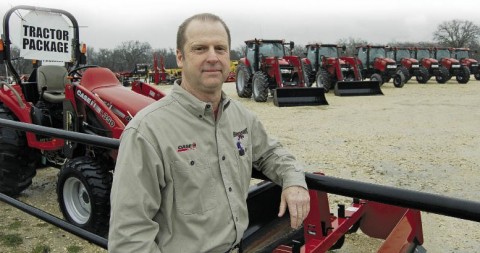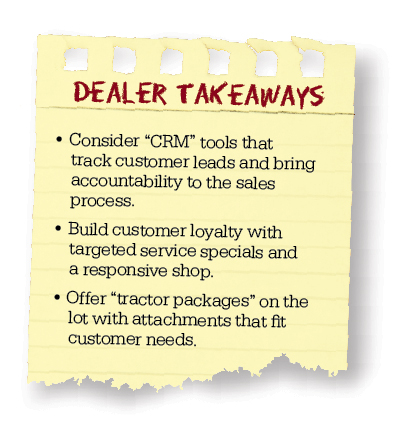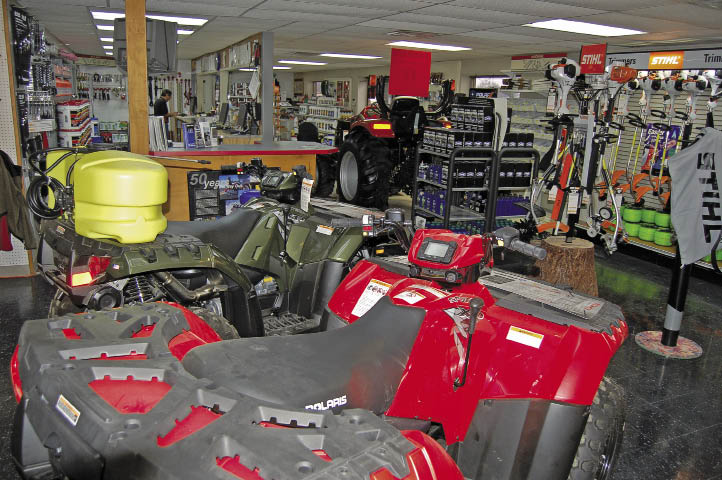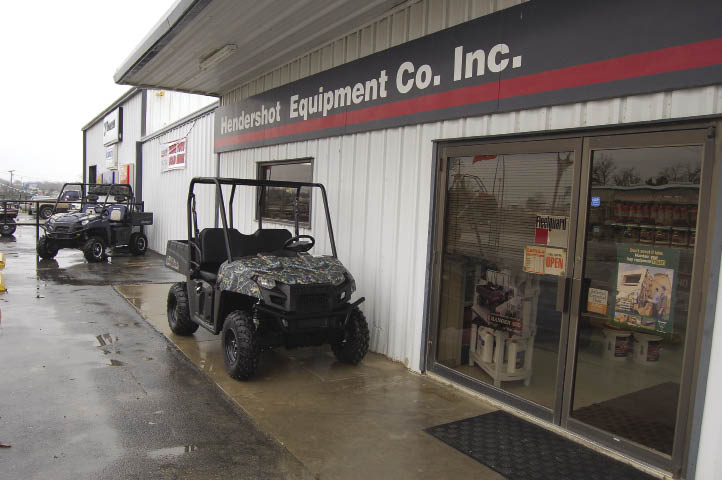One way to determine an equipment dealership’s mettle is to watch how managers and employees handle adversity.
Not long ago, Hendershot Equipment faced such a test.
In north Texas, 2009 started off with 13 inches of blowing rain, followed by a months-long drought. Bad news about the economy rained down almost daily. Then the market bottomed out for dairy farmers, a crucial market segment for the dealership
Ron Hendershot, Jr., the dealerships’ owner/principal, told his employees this: “Come to play every day, no matter what cards we’re dealt. If you do that, good things will happen in the end.”
By stocking more of the right equipment, aggressively tracking sales leads and realizing the full potential of the Internet to attract business, Hendershot Equipment has suffered less than many of its rivals. As the economy improves, managers can spend time strengthening business, rather than rebuilding it.
“No matter what happens, we’re going to wake up and come play tomorrow,” Hendershot says. “I think a lot of dealerships can get in that dip, and it’s easy to do. I just don’t let that happen.”

A Diverse Market
Hendershot Equipment |
Hendershot Equipment — with two locations 85 miles apart in Decatur and Stephenville, Texas — is a major player in the Dallas-Forth Worth ag equipment market.
The Stephenville location, about 70 miles southwest of Fort Worth, opened in 1990.
The Decatur dealership, 42 miles north of Fort Worth, opened in 1992 and has a similar customer base to Stephenville, but fewer dairy farms.
Case IH is the flagship brand, but Hendershot Equipment is also a prominent dealer of Vermeer haying equipment, Polaris all-terrain and utility vehicles, Hustler zero-turn mowers and Stihl outdoor power equipment.
Hendershot has carried most of those lines for several years, and he’s very careful when he chooses new ones. Having worked with his father in the construction business laying gas, sewer and water lines, he learned the importance of controlling costs and avoiding costly breakdowns.
Hendershot also knows what it’s like to be a customer who’s buying equipment. Before adding a new brand or line to the stor’s offerings, he talks extensively with his parts and service managers and discusses the warranty claims procedures with the manufacturer.
Any new shortline must add value, Hendershot says. And he’s not afraid to walk away from a deal — even if it costs the service department some potential business.
“We want to provide the complete package,” he adds. “A lot of dealers say that, but they don’t show it. They’ve got every color out there and they know they don’t have the right tools or parts for them.”
Hendershot says he’s seeing more loyalty from customers today — not so much with brands, but with dealerships who sell them the right equipment for their job, fix their equipment on time and communicate honestly, even if it’s something customers don’t want to hear.

“If customers feel confident in you, and believe that you’re trustworthy, they’ll still do business with you,” he says. “But if you mess it up just one time, they won’t.”
Brands like Polaris, Dixon and Stihl were picked up by Hendershot Equipment many years ago after passing muster with the sales staff and parts and service managers. “We want to provide the complete package” to customers, owner Ron Hendershot says. “A lot of dealers say that, but they don’t show it.”

|
Making the Adjustments
Hendershot Equipment doesn’t have many row-crop farmers in its market, but dairy farmers that manage herds numbering anywhere from 500-3,000 figure prominently.
In recent years, Hendershot has noted an increase in equipment sales to rodeo enthusiasts and horse owners in the Stephenville market, and there are a handful of vacation properties and hunting operations.
Customers who rope cattle usually have an arena, so they need a tractor with adequate horsepower to pull small tillage tools to maintain the grounds. They also may need balers, spears and skid-steer loaders to process and handle hay for the animals.
Many of Hendershot’s customers work part- or full-time jobs during the week and grow hay or rope cattle with the remaining time. They’re less likely to pinch pennies and want to use their equipment when they’re ready, he says.
He doesn’t like to call them hobby farmers, large-property owners, sundowners, gentleman farmers or other names. They’re simply customers, and to meet their demands Hendershot has made some adjustments.
Stock It to Sell It. A few years back, Hendershot took a hard look at his inventory and decided to spend a little less money on advertising and have a deeper supply of tractors, balers, shredders and other equipment on the lot.
The lineup of Case IH tractors ranges from 40-140 horsepower, but he’s stocking at least four or five of each model.
“I’m not into this pre-sell stuff. You’ve got to have it on the lot for the customers to feel, touch and drive. It’s hard to sell off a brochure in this business,” he says.
Revving Up the Shop. A major challenge Hendershot Equipment, and many other dealerships face is drawing and keeping repeat business once they’ve sold someone a tractor, baler or other equipment.
Hendershot says persistence is the key. “We’re finding our customers need to be reminded to do certain things,” he says. “I don’t think they always go to another dealership, it’s just that some equipment maintenance gets overlooked because they have busy lives. They overlook the manuals and don’t do things when they need to be done.”
Hendershot decided to get more aggressive this year in pursuing aftermarket business. Working with his suppliers, his dealerships will soon be contacting customers at regular intervals with letters, e-mails and phone calls about service-related issues.
For example, customers may get a letter notifying them that their equipment goes
In recent years, Hendershot Equipment has achieved several important milestones, including being named as Best-in-Class dealer in 2007 by Farm Equipment, Vermeer Platinum Dealer and Polaris Gold Master Elite Dealer.

|
out of warranty soon. Or they’ll receive flyers with winter maintenance suggestions, with an incentivized invitation to bring their equipment into the dealership if they can’t do the work themselves.
Hendershot say his goal isn’t to sell customers 100% of the time, but give them more reasons to stay loyal.
“We hope, when it’s time to trade, that they don’t want to leave that dealership with the red tractors because they’re always getting information on how to keep their tractors and balers running,” Hendershot says.
The Repair Forecast. Hendershot has asked service technicians to identify potential problems with equipment and discuss them with customers, rather than suggesting quick fixes to save them money.
Customers don’t want to be broken down with something like a $200 belt, especially when they’ve invested $20,000 or $30,000 on a baler and their livestock or horses must be fed.
“This is especially true with customers who’ve been doing business with us for a while, who trust us,” he says. “If it takes something to get the equipment fixed — whatever it may be — and they can get going again, that’s what they want.”
Get On the Same Page. Hendershot signed up employees to attend training with the SouthWestern Assn. to re-enforce the importance of customer satisfaction.
They did video training about answering phone calls, handling sales properly, dealing with disgruntled customers and other similar issues. Hendershot sees value in this training because employees gain the confidence needed to handle difficult customer situations.
He’s also stepped up product training for salesmen, citing the large percentage of customers today who arrive on the lot having already done some research about their equipment options.
He also wants employees to be viewed by customers as being professional and knowledgeable. So he’s named his sales people as “tractor pros” and the parts and service employees as “parts pros” and “service pros.”
The tractor pros handle sales of tractors, balers, shredders and used equipment. Hendershot gives parts employees an opportunity to sell Polaris equipment so they can stay fresh and learn how to be more proactive with customer needs.
He’is going to great lengths to make sure customers feel welcome in his stores.
“When a customer comes in — and I know you’re going to hear this from a lot of dealers — they meet the parts people and the service people. We make sure that gets done,” Hendershot says.
“A lot of dealers pay that lip service. The difference is those who do it all the time, and those who do it some of the time.”
Chasing Every Lead
The redevelopment of some traditional farms into small-scale agriculture, hunt clubs, tourism-oriented ranches or recreational activities also means changes for dealerships that serve those markets.
This churning of rural properties often produces a new breed of customer whose needs are much different than their predecessors. They might not be familiar with what local dealerships offer beyond price, and their first impression may be catching a glimpse of a dealership from the highway, or through a dealership’s web site.
In recent years, Hendershot Equipment has focused on driving customers to its dealerships, capturing their information and insights and using that to plot a course for future decisions.
He wants to know if his dealership’s advertising is working, how well his salespeople are sealing the deal, or if customers are clamoring for a certain type of equipment that isn’t on the lot.
To answer those kinds of questions, Hendershot Equipment has invested in several areas to track customer leads and give sales people more opportunities to sell equipment, parts and service.
Directing Traffic. A few years ago, Hendershot signed his dealerships up to use Traffic Log Pro (TLP), a customer relationship management (CRM) software tool that was developed by power-sports professionals.
TLP helps retailers better manage the efforts of sales staff for both accountability and follow-up. More than 1,500 dealers across the U.S., Canada and England have been trained to use the program.
Through being a Polaris dealer, Hendershot says he’s noticed how the company “is really focused on how many people come through the door, how many people leave the dealership without buying, and how many come back.”
Hendershot uses TLP at his dealerships to track wholegoods sales. When customers enter the store to do business, employees log the source of the lead — whether it’s a cold call, a drive-by visit, advertising, a local event or the dealership’s web site.
Hendershot can see how many sales leads came from individual salespeople, and he can break it down by equipment model or a particular time period. He can also measure the interest level in certain equipment models, and whether a customer attempted to price out the same equipment between his two stores.
A major benefit to Hendershot in using TLP to track where his salespeople are with potential customers in wholegoods sales. “Step 1” in the CRM program is a handshake, “Step 4” is sitting down and pricing equipment, “Step 8” is closing, and “Step 9” is delivery.
“It helps me manage and see what the salespeople are pricing and what they’re not pricing,” he says. “It’s not fancy, but it’s done a great job for us.”
Embracing the Web. Over the years, Hendershot says, something has been driving customers to his dealership’s web site, and traffic has steadily increased.
Realizing the potential to drum up new business, he’s invested heavily in the redevelopment of the dealership web site, www.hendershotequipment.com. He often promotes his dealership’s ability to offer “tractor packages” to customers who have specific job requirements but may not know what types of attachments should be included.
In 2010, packages were promoted on the web site with special names that could interest specific customer groups:
• The Ranch Hand: Case IH Farmall 45, 4WD tractor paired with a Case IH L350 loader and RC720 shredder and PJ 20-foot trailer;
• The Weekender: Case IH Farmall 40, 4WD tractor and L350 loader;
• The All Around: Case IH 55, 4WD tractor with power shuttle transmission, L360 loader and RC720 shredder;
• The Top Hand: Case IH Farmall 80 cab 4WD tractor with L730 loader with a spike;
• The Arena Special: Case IH Farmall 40 tractor; L350 loader and bale spear, and Parma 6-foot arena groomer;
• The Champ: Case IH F40 Farmall Hydro tractor, L350 loader and Case IH 78-inch tandem disc.
Using special names like The Weekender and The Top Hand, Hendershot Equipment heavily promotes via the dealership’s web site its ability to offer “tractor packages” to customers who have specific job requirements but may not know what types of attachments should be included.

|
Hendershot’s web site also leaves a place for customers to add their e-mail address to be notified of discounts and special promotions.
“The key to a successful web site is updating the web site every month,” he says. “If you don’t, you become stagnant and that’s not good.”
Point Person for Marketing. As the web has driven sales leads to the dealerships, Hendershot decided someone needed to handle marketing duties full-time and keep the momentum going.
In 2009 — notably, during a difficult sales year — Hendershot created a full-time marketing-coordinator position for his two dealerships.
“I feel if I can increase the hits to my employees, they can take the business. But how do you get those hits?” he says. “I’m into that e-mail drip and direct marketing. I don’t have the time to design templates, so I created that position.”
This employee’s job is to keep the dealerships’ web site and Facebook page updated with new photos, promotions and information; organize and manage customer lists; send out e-mails to customers about promotions and events; remove bad e-mail addresses from the customer database; and manage the content for in-store TV monitors and get feedback.
Fine-tuning the customer list was one of the first assignments. “Nothing burns my butt more than sending an e-mail out and it’s coming back because it’s the wrong address,” Hendershot says.
There has been a slight return on investment with this position, but the primary benefit is having someone focused on the dealership’s marketing efforts, he says.
Completing the Circle
Hendershot has learned from his “20 Group” consultant, Dr. Jim Weber, that dealership owners can’t manage what they don’t measure.
He already knows this through the high value he places on the aftermarket performance of his dealerships, which have an absorption rate well over 90%.
After solidifying his business model and building a team of capable employees, marketing is the new challenge that keeps him up at night. He wants to complete the circle of performance benchmarks to include wholegoods sales, service, parts sales and marketing. “If I can complete that circle, I’ve got something,” he says. “The technology is there now to give me the answers back, and that’s a big deal.”





Post a comment
Report Abusive Comment